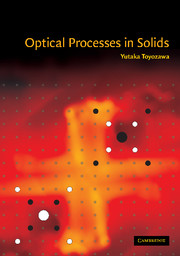Book contents
- Frontmatter
- Contents
- Preface
- Acknowledgments
- List of principal symbols
- 1 Radiation field
- 2 Quantum mechanics
- 3 Interaction of radiation with matter
- 4 Electronic vs. nuclear motions and the optical spectra of localized electrons in solids
- 5 Lattice vibrations
- 6 Electric susceptibility and dielectric constant
- 7 One-electron states in solids
- 8 Excitons
- 9 Polaron and the self-trapped state
- 10 Optical spectra of exciton in the phonon field Overview
- 11 Higher-order optical processes
- 12 Inner-shell excitation
- 13 Photo-induced structural changes
- 14 Light, matter and life (A scenario for the origin of life and its evolution)
- Appendix 1 Derivation of exciton Hamiltonian from many-body Hamiltonian
- Appendix 2 Transient spectra for second-order optical processes
- References (by chapter)
- Subject index
5 - Lattice vibrations
Published online by Cambridge University Press: 10 December 2009
- Frontmatter
- Contents
- Preface
- Acknowledgments
- List of principal symbols
- 1 Radiation field
- 2 Quantum mechanics
- 3 Interaction of radiation with matter
- 4 Electronic vs. nuclear motions and the optical spectra of localized electrons in solids
- 5 Lattice vibrations
- 6 Electric susceptibility and dielectric constant
- 7 One-electron states in solids
- 8 Excitons
- 9 Polaron and the self-trapped state
- 10 Optical spectra of exciton in the phonon field Overview
- 11 Higher-order optical processes
- 12 Inner-shell excitation
- 13 Photo-induced structural changes
- 14 Light, matter and life (A scenario for the origin of life and its evolution)
- Appendix 1 Derivation of exciton Hamiltonian from many-body Hamiltonian
- Appendix 2 Transient spectra for second-order optical processes
- References (by chapter)
- Subject index
Summary
Simple crystal lattices
Atoms in molecules and solids are bound together by the valence electrons which have been supplied by them and are shared among them. In this chapter we will consider the motion of atoms under given interatomic forces without asking about their nature – the electronic origin of the bonds. We will confine ourselves to solids and study some simple characteristics of the atomic motions within them – lattice vibrations – brought about by the periodic structure of the crystal lattice. The lattice vibrations will turn out to be a prototype of elementary excitations in a solid, other examples of which will be given in later sections.
Consider an assemblage of a great number (N) of identical atoms with interatomic potential ν(r) which typically is attractive except for the hard-core repulsion, and let them be arrayed in one-dimensional space with positions x1, x2, … in increasing order. In the approximation that only the nearest neighbor potentials are considered, as is allowed when ν(r) is short ranged, the total potential energy is given by U ≃ ν(x1 – x2) + ν(x2 – x3) + …, and the most stable arrangement of the atoms is a periodic array with equal distance a at which ν(r) is a minimum.
- Type
- Chapter
- Information
- Optical Processes in Solids , pp. 69 - 88Publisher: Cambridge University PressPrint publication year: 2003

